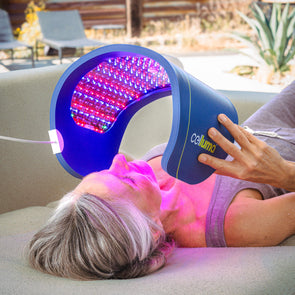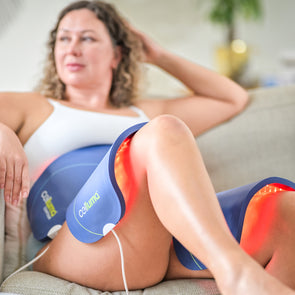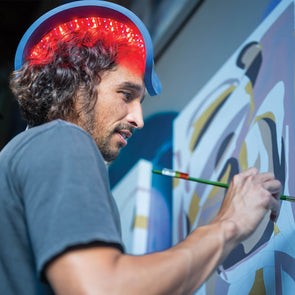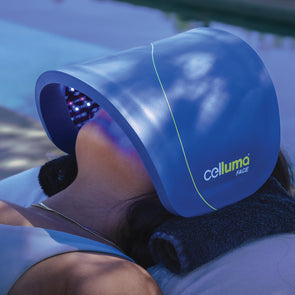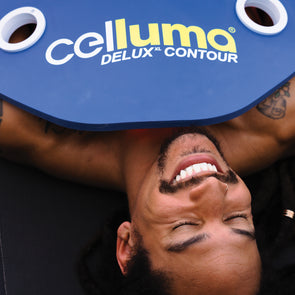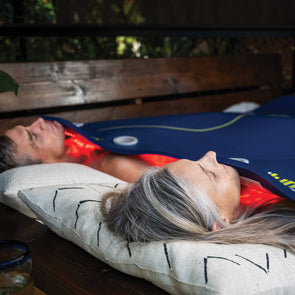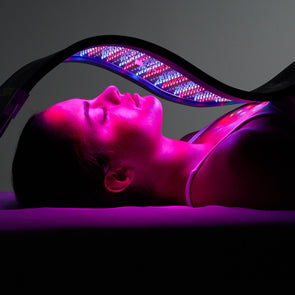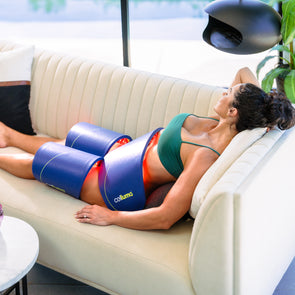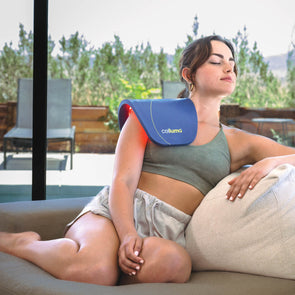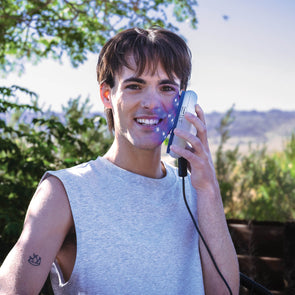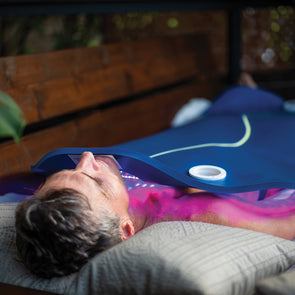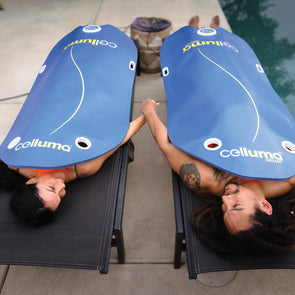A Guide to Red Light Therapy: 9 Commonly Asked Questions

Chances are, you’ve heard about LED light therapy, also sometimes known as low-level laser therapy or photobiomodulation. It’s regularly featured in the news, and everyone from celebrities to professional athletes and Instagram influencers are hopping on the red LED light therapy (also known as RLT) bandwagon and adding it to their skin care routines and treatment options. Below are some of the healing benefits you might expect from red light therapy treatments for skin (fine lines and wrinkles), pain and hair conditions.
Skin and Health Benefits
Although the healing benefits of LED (light emitting diodes) light therapy might seem like a modern-day miracle, it’s not a new concept to the medical community. In fact, RLT was first discovered more than 100 years ago.
However, as LED light therapy has grown in popularity, so have questions surrounding its efficacy and treatment potential for conditions like acne, sun damage to the skin, fine lines and wrinkles and even inflammation.
What is LED Light Therapy?
In its most basic definition, infrared LED light therapy is the application of specific wavelengths of light energy to the body to upregulate cellular performance and achieve therapeutic benefits, including treatment for anti-aging, pain management, wound healing and even hair restoration. It is also a cost effective and non-invasive treatment option.
What the Research Says
Infrared LED light therapy has been studied and tested in thousands of clinical trials over the past few decades, and it has proven to be a safe and effective treatment option with no negative, harmful, or long-term side effects. No matter what your body or skin care routine, red light therapy can provide some amazing benefits and reduce those under eye wrinkles and the fine lines as well. It’s an effective, non-invasive, low-touch treatment option.
What Does RLT Do?
As the manufacturer of the most medically credentialed light emitting diode device on the market today, we’ve encountered many questions over the past decade about red and infrared light therapy, skin care and pain treatment options.
 Questions about red light therapy? We’ve got answers.
Questions about red light therapy? We’ve got answers.
Below are answers to the 9 most commonly asked questions about infrared LED light therapy:
- How long has red light LED therapy (low-level laser therapy) been around?
- What is red light LED therapy?
- How does red light LED therapy work?
- What can red light LED therapy do?
- Is red light LED therapy safe?
- What are the side effects of red light LED therapy?
- How much do red light LED therapy treatments cost?
- How often should I use red light LED therapy?
- Where can I buy a red light LED therapy device?
How Long Has Red LED Light Therapy Been Around?
Red LED light therapy first gained prominence in 1903, when Danish physicist Niels Ryberg Finsen was awarded the Nobel Prize for his invention of light therapy for skin tuberculosis. However, red LED light therapy has come a long way in the 100+ years since and its treatment benefits are much more widely understood.
NASA and Red Light Therapy
NASA scientists first used RLT to stimulate plant growth on international space stations in the 1980s, and then began investigating the potential benefits of light therapy for astronauts on long-term space missions, shortly thereafter.
Astronauts are required to work in very irregular conditions, and they often become susceptible to health risks such as muscle and bone atrophy and delayed wound healing during extended space missions. This observation led scientists to discover that human cells require gravity to stimulate growth, and any fluctuation in gravity will disturb overall cellular function.
Treatment Potential
Using that logic, NASA tested red light therapy on astronauts, and found that it had the ability to improve cellular function and combat the effects of living in zero gravity environments. According to a NASA-article from 2002, “LEDs stimulate the basic energy processes in the mitochondria (energy compartments) of each cell,” and an LED blanket device was found to be effective in the prevention of bone and muscle atrophy. Based on NASA’s findings, the medical community at large began to research and recommend Red Light Therapy for its therapeutic treatment potential.
What is Red LED Light Therapy?
Red and infrared LED light therapy is the application of specific wavelengths of light energy to human tissue to obtain therapeutic benefits. Red and infrared wavelengths penetrate deep into the skin’s dermal and subcutaneous layer to specifically target cells at the source. The energy absorbed by the cells is then used to naturally improve cellular performance. The visible results include an improvement in the tone and texture of the skin as well as a reduction of inflammation.
Red Light Therapy Definitions
Similar to low-level laser therapy, low-level light therapy delivered via light emitting diode (LEDs) devices, has the potential to treat a variety of skin (wrinkles and acne) as well as pain conditions and even hair and scalp conditions. You might have heard people refer to Red Light Therapy in a number of ways:
- Low-Level Laser Therapy
- Light-Activated Biostimulation
- Phototherapy
- LED (Light Emitting Diode) Therapy
- Photobiomodulation
- Near Infrared Light Treatment
No matter what you call it – the science behind red and infrared light therapy is the same.
How Does Red LED Light Therapy Work?
Like plants absorb sunlight to power photosynthesis and boost tissue growth, human cells can absorb light energy to stimulate cellular function and enhance overall cellular performance. An example of this are fibroblasts upregulating to increase the production of collagen and elastin. Red light therapy also boosts circulation to deliver oxygen and nutrients to living tissues.

Rejuvenating the Skin
In other words, human cells can absorb particles of light (photons) and transform that energy into adenosine triphosphate (ATP), the main source of energy that cells need to power metabolic processes. The resulting elevation of ATP is then used to upregulate cellular performance and repair tissue damage. When your body absorbs particular wavelengths of light energy, it converts that energy to produce more ATP, thus boosting the body’s natural ability to regain and maintain vitality. The results may reduce the appearance of fine lines and wrinkles as well as inflammation in the body.
What Can Red LED Light Therapy Do?
RLT is constantly being tested to evaluate its efficacy for a number of different conditions, and the FDA currently recognizes light therapy as a proven solution for skin issues related to acne and anti-aging, as well as pain management and hair restoration.
Skin and Pain Conditions Addressed
There is evidence to suggest Red Light Therapy can also relieve the following conditions:
- Delayed wound healing
- Hair growth in people with certain types of alopecia
- Pain from carpal tunnel syndrome and arthritis
- Faster healing of diabetic foot ulcers
- Inflammation from psoriasis
- Fine lines, wrinkles, and sun spots
- Recurring cold sores from herpes virus
- Scar tissue formation/appearance
- Muscle and joint recovery after physical activity
- Itching from eczema
- Reduce chemotherapy side effects
- Muscle stiffness and spasms
- Reduce appearance of stretch marks
The list of red light therapy benefits is impressive, and it has the potential to grow as additional clinical trials are performed on various treatment options and protocols.
Is Red Light Therapy Safe?
Red light therapy is safe and clinically proven for the treatment of a variety of skin and pain management conditions. Red light therapy is also non-toxic, non-invasive, and a cost effective alternative to prescription drugs, invasive surgery and harsh topical skin treatments. Unlike other types of light therapy treatments, low-level light therapy LED machines do not contain ultraviolet rays (UV rays from the sun), so there is no risk of cancer-causing damage to skin tissue. In comparison to low-level laser therapy, LEDs generate negligible amounts of heat and are not considered a significant risk to the general population. From skin issues like acne and fine lines, to inflammation and other general pain conditions, red light therapy provides therapeutic benefits that go beyond skin deep.
What Are the Side Effects of Red LED Light Therapy?
In general, side effects from Red Light Therapy are rare. If they do occur, they typically involve temporary redness of the skin in the treated area. Side effects are minor and do not last long. Red light therapy treatment is non-invasive, painless, requires no recovery time, and can be used on all skin types and tones.
How Much Do Red LED Light Therapy Treatments Cost?
Red light therapy cost varies depending on where you live, but one 30-minute session at a dermatologist’s office can range from a cost of $25 - $85 or more.
You know the saying, “you get what you pay for,” so don’t simply go with the least expensive device. While there is a range of red light therapy costs, do your homework. When investing in a quality device, remember that not all devices are created equally. Select an FDA-cleared option to ensure the efficacy, safety and results of professional-grade equipment.
If red light therapy cost is of particular concern for you, it’s important to remember that you are investing in your own health (if using at home) or the health of your clients if you are a professional user investing in your business.
A Daily Skin Routine
If you’re looking to incorporate infrared light therapy into your weekly self-care body and skin routine, it’s recommended that you purchase a professional-grade device. All factors considered, spending a little extra on high-quality light therapy is well worth the investment.
Get Rid of Fine Lines
Take the Celluma SKIN, for example, which simultaneously treats both acne and aging. If you were to use Celluma SKIN 3x per week for a year, the total cost breakdown would equal approximately $10 per treatment. After 2 years? The cost is only $5 per treatment, a bargain by any standard. Everyone’s skin is unique but most people suffer from more than one skin condition and red light therapy devices can help you combat multiple issues. Celluma devices can help keep your acne in check, as well as your inflammation while eliminating those fine lines and wrinkles. Whole body treatment — all in one device!

How often should I use red light LED therapy?
RLT is more effective if you keep up with treatments on a regular basis. For anti-aging, for example, most professionals recommend 2-3 treatments per week. How often you use light therapy is often dependent on your time and monetary budget. Keep in mind that light therapy is cumulative so more is usually better, but be sure to consult with your physician or skin therapist for treatment guidance.
Where can I buy a red light LED therapy device?
There are a number of red and infrared light therapy devices on the market – you can even find products on Amazon. However, much like other “too-good-to-be-true” deals, you should be cautious before you buy.
FDA Clearance Matters
If you want to invest in red or infrared, or combination light therapy device, it’s worth the money to buy an FDA-cleared device; that way, you can rest assured that the machine has been reviewed for safety and for effectiveness. Inexpensive, non-regulated devices are often ineffective, or stop working completely. These unregulated machines are often responsible for negative reviews on light therapy devices, an otherwise scientifically proven and highly effective modality. If you are located in the UK or European Union then look for devices that are medically CE-Marked like Celluma.
Cost versus Benefits: Do Your Research
Bottom line? Do your research and trust the professionals. Purchase a reputable device that has a proven track record of success – one that professional dermatologists and estheticians use with their patients every day.
Although Red Light Therapy has been around since 1903, it has more recently become a mainstream method that people use to treat a wide variety of skin and health concerns. Celluma manufactures FDA-cleared and medically CE-Marked, professional-grade light therapy devices that can be used in-office or for treatment at home and on-the-go. Our portable, lightweight designs are ideal for storage and travel, and our patented shape-taking memory technology ensures you can conform the LED light close to your body for maximum energy absorption, optimal efficacy, and effective treatment.
Amazing Skin Benefits
Our red and infrared light therapy devices improve health at the cellular level by accelerating the repair and replenishment of compromised tissue cells. While similar devices claim to do the same, they often require you to buy multiple panels and accessories in order to treat specific conditions or accommodate different body parts.
Alternatively, Celluma offers a convenient solution in a versatile, all-in-one system you can trust. If you’re ready to try red and infrared light therapy for yourself, Celluma is the #1 choice globally. Celluma devices are inspired by light and proven by science to improve cellular health and reduce the signs of aging, relieve pain, speed healing, and so much more.
Bonus Question: What about LED Red Light Therapy and the Sun?
There is some substantial research available regarding LED red light therapy and the effects of the sun on skin health. Daniel Barolet, in his study “LED Photoprevention: Reduced MED Response Following Multiple LED Exposures,” looked at the impact of sun light on skin health and how LED light therapy might help reduce UV skin damage.
Here’s what the study had to say: “The solar radiation that reaches human skin ranges from 290 to 4,000 nm and includes ultraviolet (UV) radiation: UV-B (290–320 nm), UV-A (320–400 nm) — which can be further subdivided into UV-A I, or far UV-A (340–400 nm) and UV-A II or near UV-A (320–340 nm), visible light (400– 700 nm) and infrared radiation (IR; 700–4,000 nm) [1]. Small amounts of UV irradiation are essential for the production of vitamin D, yet when the skin is subjected to excessive radiation, deleterious effects may occur.
It is commonly accepted that the UV range (<400 nm) exposure is responsible for almost all deleterious photo-induced effects on human skin. Some of the possible mechanisms for UV skin damage are collagen breakdown, the formation of free radicals, interfering with DNA repair, and inhibiting the immune system [2]. At this time, minimizing the amount of UV irradiation that reaches the skin remains the only method for protecting skin against UV-induced damage. This is achieved mostly by avoidance of sun exposure and the use of traditional sunscreens. The photoprotective efficacy of topical sunscreens is dependent on its own limitations which include water or perspiration, spectral limitations and user allergies as well as compliance.
It has recently been suggested that protective mechanisms against skin UV-induced damage may be activated by IR exposure in a number of in vitro studies using primary culture human fibroblasts. In a study by Menezes et al. [3], it was demonstrated that a narrow electromagnetic spectrum window IR wavelengths (700–2,000 nm) generated a strong cellular defense against solar UV cytotoxicity in the absence of rising skin temperature. In a follow-up to this study by Frank et al. [4], it was proposed that IR irradiation prepares cells to resist UV-B-induced damage by affecting the mitochondrial apoptotic pathway.”
Taking all of these factors into account, the study concluded that, “although additional in vivo and in vitro studies with larger patient cohorts are required, these findings represent another step forward as part of the expanding field of LED Photoprohylaxis applications in dermatology. This promising approach has the advantage of being easy and practical to perform and appears extremely safe for the skin and eyes, and not affected by water or perspiration or any physical or environmental factors as are traditional sunscreens. If these results are corroborated, this innovative method could provide an effective and practical photoprotective modality with a sun protection/prevention factor of SPF-15 against upcoming—acute and/or chronic—skin damage caused by UV radiation. This photobiochemical therapy could be very useful in dermatology as a preventative therapeutic modality against upcoming photodamage like first degree sunburn, for patients having drug phototoxic reactions or those with photosensitivity disorders such as PLE or SLE, and possibly in the prevention of pigmentary disorders.”
Red Light Therapy Devices at Your Fingertips
You can shop our wide range of award-winning red light therapy devices here:
If you have any questions about which device is right for you, feel free to call our team of experts at (714) 978-0080.


